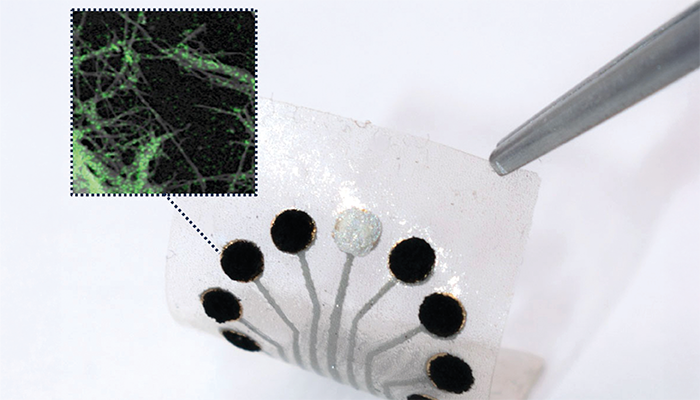The UCLA-developed TMR sensor enables real-time monitoring of a wide range of metabolites. Inset: A spectroscopic image shows on-electrode molecules that drive metabolite-sensing reactions.
Credit: Xuanbing Cheng and Zongqi Li/Emaminejad Lab
A team of researchers led by UCLA has developed a bioelectronic sensor that mimics metabolic pathways to continuously monitor a broad range of metabolites in real time. The platform leverages natural enzymatic reactions and nanoscale engineering to overcome longstanding limitations in dynamic metabolite detection.
The new technology – termed “tandem metabolic reaction-based” (TMR) sensing – uses a modular electrode architecture built from single-wall carbon nanotubes (SWCNTs). These electrodes are functionalized with enzymes and cofactors selected to mirror the body's own metabolic networks. When exposed to target metabolites, these enzymes catalyze electron-exchange reactions that generate a measurable current.
"To understand how metabolites affect biological processes or reflect health, we need to monitor different groups of metabolites based on our specific interest," said senior author Sam Emaminejad, a professor at UCLA’s Samueli School of Engineering and member of the California NanoSystems Institute, in a press release. "So we aimed to develop a sensor platform that can be applied to a wide range of metabolites while ensuring reliable operation in the body."
The TMR system extends beyond the single-step enzymatic reactions of conventional biosensors. By integrating cofactors – essential molecular partners in many biological reactions – it supports cascades of biochemical transformations. This enables detection of over 800 metabolites directly, and over two-thirds of known metabolites with the addition of just one conversion step.
The SWCNT-based electrodes also provide a high surface-to-volume ratio and enhanced electron transfer properties, resulting in high signal-to-noise ratios and low-voltage operation. “This allowed us to achieve exceptionally high signal-to-noise ratio measurements across a wide range of applications,” said co-first author Xuanbing Cheng, a postdoctoral researcher in Emaminejad’s lab.
Validation experiments demonstrated the sensor's versatility. The researchers measured clinically relevant metabolites – including lactate, uric acid, and glutamate – in saliva and sweat samples from patients with neurological or metabolic conditions. The system also successfully detected a gut-derived metabolite in cerebrospinal fluid, highlighting its potential for investigating the gut-brain axis.
Rather than replacing high-throughput lab techniques such as mass spectrometry, the authors see TMR sensors as a complementary technology for in vivo or near-patient monitoring. “We’re harnessing nature’s own blueprint and molecular machinery to track the very biochemical processes they sustain,” Emaminejad said.
“These tandem metabolic reaction–based sensors can catalyze the advancement of metabolomics from in vitro to in vivo settings,” wrote the authors.
Future directions include adapting the sensor for continuous monitoring in clinical settings, drug development, or industrial biomanufacturing. One particularly promising area is in decoding the time-dependent communication between the gut and brain.
"A tool that tracks metabolites continuously, rather than relying on single lab measurements, could help reveal this two-way communication," said Emaminejad. “We’re finally equipped to test important hypotheses that lacked key data.”





